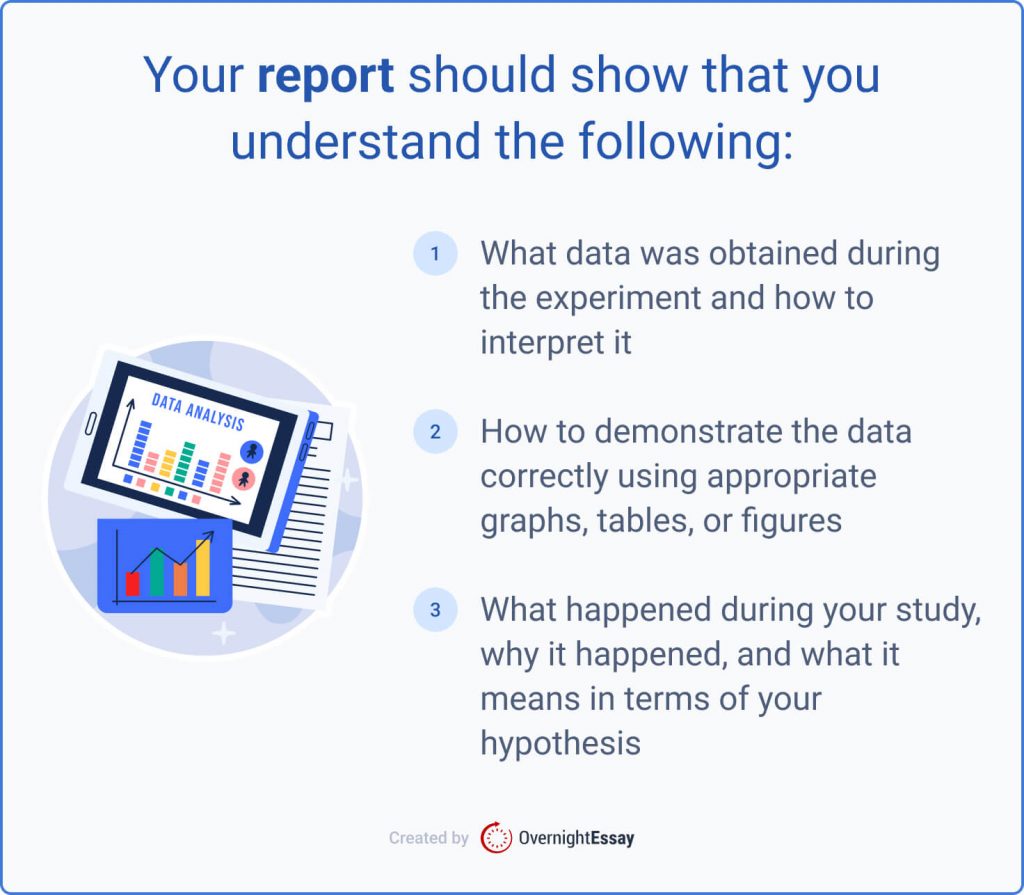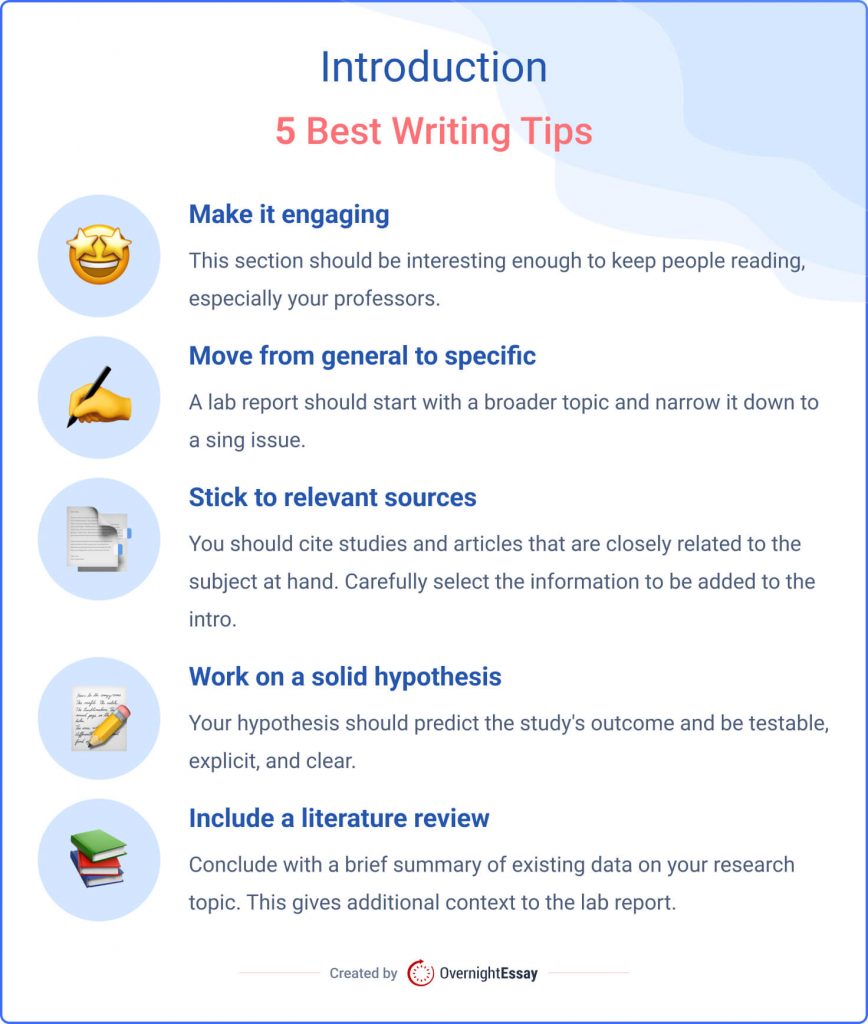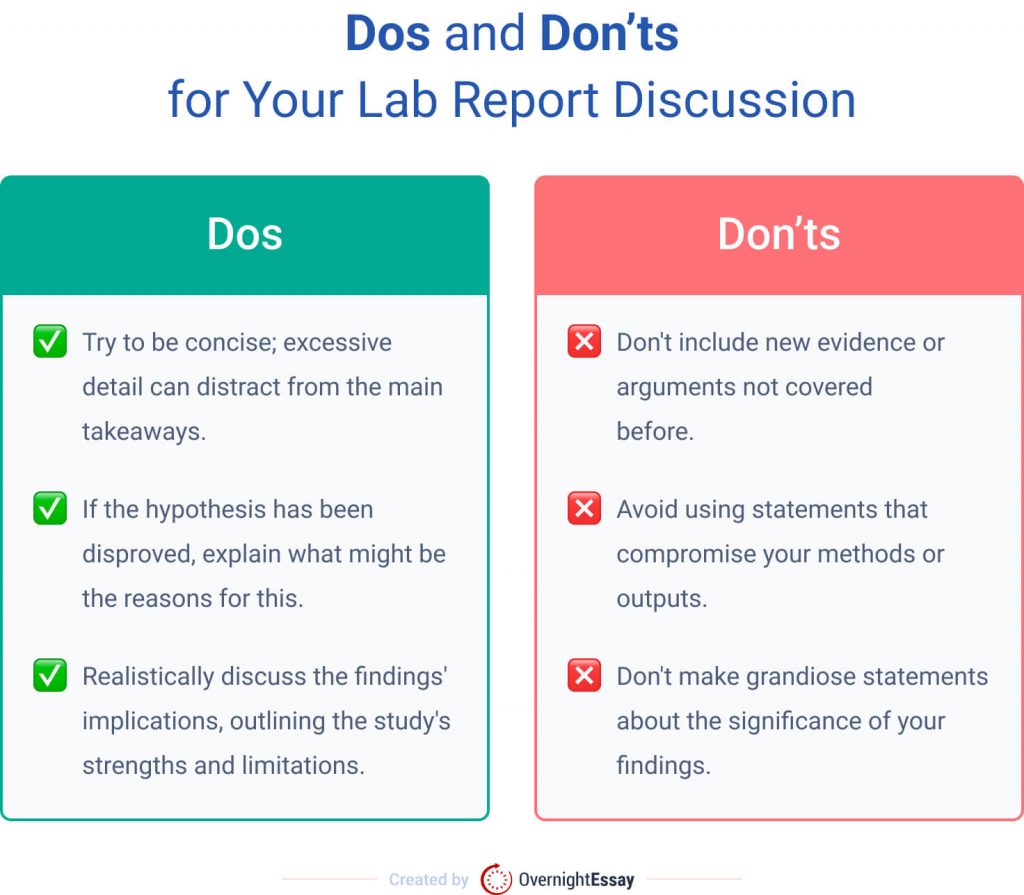Lab reports detail the course of experiments and their findings. These records are an essential form of communication in academic, professional, and business circles. Our team designed this article as a guide to lab report formatting and its nuances. It will provide valuable tips and examples. They will help improve your reports’ structure, consistency, and visual appeal, making them reach a new level of quality. We’ll examine the main components of these documents, including the title page, abstract, introduction, methodology, etc.
Without further ado, let’s get to the core of high-quality report writing.
🧪 Lab Report Writing Format
A well-written lab report allows others to comprehend and recreate your experiment.

The following components of lab report are used to give a clear picture of the research results:
- Abstract. This section provides a summary of the purpose and course of the experiment. Write one paragraph (about 100-200 words) to detail the main findings and their significance to the discipline.
- Introduction. Here, you introduce the problem and its theoretical background. Remember to include the motivation for the research and your hypothesis with a brief explanation of the issue.
- Methods. In this segment, students list the methods and materials used during the experiment. These may include substances (exact amount) and equipment utilized in the process. Here, you should also detail all the steps of the investigation.
- Results. One of the main elements of lab report writing format involves displaying and evaluating the collected data. This section often provides charts, graphs, and other figures. Ensure to enumerate them and format appropriately so readers understand what you’re talking about later.
- Discussion. It is a crucial part of the paper that analyzes the results. Here, you can go over the strengths and weaknesses of the experiment’s design and compare them to those of similar cases. Address any errors and evaluate them using relevant theories and terms.
- Conclusion. This section contains the summary of the experiment. You should explain what you learned during the experiment and why it’s crucial. If any additional work is necessary, remember to mention this in the conclusion.
- References and appendices. The last portion of the lab report contains outside sources used to back up your claims or explain background data. If you didn’t rely on external information, there’s no need to include a references section.
7 Helpful Tips for Report Writing Format
We’ve decided to provide several important pieces of advice for all college students. You can use our tips to polish your writing skills to create the perfect lab report format. Here are the most important of them:

- Track your objectives. Before writing your paper, enumerate what you want to achieve from the experiment.
- Make a draft. Remember to make an outline that lays out the report’s structure so that you remember to include all the crucial facts.
- Double-check your calculations. Ensure you have all the numbers right. Otherwise, you might get false results.
- Work with valid sources. Your lab report should only use peer-reviewed content for its theoretical and empirical data.
- Avoid personal opinions. Never write arguments that lack evidence or are based on your subjective opinion.
- Write from the third-person perspective. Your report should be written in the past tense and use the third-person passive voice.
- Learn from others. Learning from examples is always a good idea, so we recommend you to look at similar papers and their structure.
🔬 College Lab Report Cover Page
A cover page tells your professors the subject of the research. It is the first thing they will read, so ensure that it’s structured right. It must include your name, the current date, and the days of your lab studies. Remember to add the experiment title, course, and program details. If you have a colleague or a lab partner who helped, include their name as well. To make the work stand out, you can summarize the results of the experiment right here.
📑 Lab Report Formatting of an Abstract
A lab report abstract briefly overviews the experiment. Here, you state its purpose, findings, and relevance to the broader field of research. This section of lab report formatting holds the most important details of the experiment. On average, an abstract is 150 words long and contains the following data:
- The precise topic of the experiment.
- Participants and location.
- A brief rundown of conditions, variables, and data collection methods.
- Significant findings and their interpretation.
- The importance and relevance of the experiment.
✍️ Report Writing Format: Introduction
This part of the lab report introduces your experiment and provides the work’s context and basis. Let’s see how to make your introduction informative and believable. In this section, you should include several things:
- Introduce the research subject. State your scientific method, review the theoretical background, and introduce the principal terms used throughout the paper.
- Give a brief overview of previous studies. Talk about who conducted them, why, what they found, and the meaning of their discoveries.
- Write a one-sentence hypothesis. Explain what you wish to gain from the research, so your reader knows what to expect.
- Include background information and a summary. Ensure that the introduction discusses the issues that weren’t covered in previous experiments.
- Use your own words. Do your best to avoid repeating the guidelines and the lab manual. Also, we recommend paying attention to the punctuation in the text.
Lab Report Formatting: Introduction Writing Tips
Students often need assistance to write catchy and well-structured introductions. We’ve included the most helpful tips to bring new quality to the opening section. Here is what will make the most difference in your lab reports:

- Make it engaging. Like with any paper, the intro must be interesting enough to keep people reading. Take the time and make the intro count, as your readers will surely notice it.
- Move from general to specific. A lab report should start with a broader topic and then narrow down to a single issue. For example, you can begin by listing facts about the substance you have investigated and gradually lead to the specific purpose of your research.
- Stick to relevant sources. Cite studies and articles that are closely related to the issue at hand. Take extra care when choosing the information that will be added to the introduction.
- Work on a solid hypothesis. A reasonable hypothesis should predict the outcome of the research. It must be testable, specific, and straightforward.
- Include a literature review. Finally, give brief information about existing data on your research topic. It provides more context to the lab report.
📚 How to Write a Report Format: Methods & Materials
Research methods and materials is a section where you can finally explain what you did during the experiment and what research tools you employed. Such information helps to assess the quality of the study. Commonly, this part of the report should contain the following details:
- Research subjects. List raw data samples used in the lab report, such as materials and substances.
- Conditions. An experiment should be conducted in a particular place and timeframe. Mention factors that influence dependent and independent variables.
- Methods. Follow specific rules when analyzing samples and calculating results. Most likely, they come with the lab manual.
- Materials. Finally, mention the instruments and tools involved in data collection. Remember to name each item model you used.
📊 Lab Report Formatting: Results
The results part contains the findings of a lab experiment. They can either support or refute the hypotheses mentioned in the introductory part. It serves as a summary of observations and data relevant to the research. Thus, you should mention the following information:
- Raw data from each part of the experiment and how it was evaluated for the final result.
- Data that will be evaluated in the discussion section (tables and figures.)
- Cases where the experiment didn’t go as planned.
- Descriptive statistics and statistical test results.
- The estimated number of standard errors.
Format of a Lab Report Discussion
Writing a practical discussion requires organization, critical thinking, and clarity of statements. We’ll give valuable tips that help you structure and write a detailed, high-quality discussion for your lab report format.

- Provide the main findings. This way, your evaluators and peers will know what to expect from the rest of the segment.
- Check how well the results relate to the theory. Explain the practical applications and theoretical implications of gathered information.
- Compare expected and obtained results. Look at the experiment’s initial goals and see if they were achieved.
- Address the strong and weak points. Evaluate the quality of the experiment, explore any errors, and how they could have been avoided.
- Compare the results to similar studies. Lastly, you can compare your results to those of your peers or similar experiments described in peer-reviewed articles.
📝 Report Writing Format: Conclusion
The conclusion part of a lab experiment gives readers a critical look at the study and its results. Check your lab manual to know which data to include in this part. The most common information in this section includes:
- Summary of the experiment, its critical points from the discussion, and its results.
- A brief overview of its limitations and strong points.
- Implications the study has in the broader research field.
- A comparison of the results to the initial objectives.
📄 Lab Report Formatting: References & Appendices
A well-structured lap report isn’t confined to the results. It also contains the necessary sources and attachments that provide extra information and make the research scientifically accurate.
💡 Ideas for Lab Report Topics
Selecting an interesting and relevant subject is crucial in writing a lab report. It will help draw attention to the work and conduct a productive experiment. Here are the 30 best lab report topics you can use for your next experiment:
- Explore the safety of pesticides in food production.
- Research methods that determine the presence of coliform bacteria in water.
- The intersection of biology and philosophy in science and nature books.
- Determine the potential risks of cholesterol buildup in the cardiovascular system.
- Experiment with the influence of gravity on non-Newtonian fluids.
- Explore the impact of high temperatures on milk.
- Conduct an experiment using Newton’s law of cooling.
- Explore the role of photosynthesis in oxygen production.
- Analyze the relationship between effective time management and academic achievement.
- The influence of business writing workshops on professional communication skills.
- Investigate the effect of vitamins on the digestive system.
- Explore the growth of bacteria strains in different conditions.
- The biological accuracy of genetic concepts in popular science fiction literature.
- Write a lab report on DNA fingerprinting.
- Research the main factors of protein separation.
- Comparative study of science education in different school curricula.
- Research the use of hyacinth plants in calcium metal removal from water.
- The use of business writing templates for improving workplace communication.
- Explore the causes of extreme cellular degradation.
- The influence of antibiotics on the human digestive system.
- The power of books on shaping public perceptions of the world.
- Explore why the Monilinia fructicola is highly resilient against fungicides.
- Analyze the dangers of using nitrates in food production.
- The influence of fertilizers on the chemical structure of vegetables.
- The role of teachers in fostering a positive learning environment.
- Examine the effect of high-frequency noises on the nervous system.
- How pollution and dust affect the human respiratory system.
- Measuring the influence of news reports on public opinion and decision-making.
- Explore the validity of statistical methods in medicine.
- Determine factors that improve the quality of radio frequencies used in Wi-Fi devices.
We did our best to examine each section of the lab investigation report format and hope our efforts will push you to be more productive in your discipline. Feel free to share a link to our article with friends and peers who struggle with report formats.